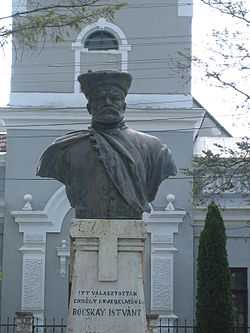Miercurea Nirajului
| Miercurea Nirajului Nyárádszereda | ||
|---|---|---|
| Town | ||
|
The statue of István Bocskay | ||
| ||
 Miercurea Nirajului | ||
| Coordinates: 46°31′48″N 24°48′0″E / 46.53000°N 24.80000°ECoordinates: 46°31′48″N 24°48′0″E / 46.53000°N 24.80000°E | ||
| Country |
| |
| County | Mureş County | |
| Status | Town | |
| Government | ||
| • Mayor | László Dászkel (Democratic Union of Hungarians in Romania) | |
| Area | ||
| • Total | 55.88 km2 (21.58 sq mi) | |
| Population (2002) | ||
| • Total | 5,824 | |
| Ethnicity | ||
| • Hungarians | 83.96% | |
| • Romanians | 10.69% | |
| Time zone | EET (UTC+2) | |
| • Summer (DST) | EEST (UTC+3) | |
| Website | http://www.miercureanirajului.ro | |
Miercurea Nirajului (Hungarian: Nyárádszereda, Hungarian pronunciation: [ˈɲaːraːdsɛrɛdɒ]) is a town in Mureş County, Romania. It lies in the Székely Land, an ethno-cultural region in eastern Transylvania.
The following seven villages are administered by the town:
- Beu / Székelybő
- Dumitreştii / Demeterfalva
- Laureni / Kisszentlőrinc
- Moşuni / Székelymoson
- Şardu Nirajului / Székelysárd
- Tâmpa / Székelytompa
- Veţa / Vece
History
It formed part of the Székely Land region of the historical Transylvania province.
Its first written mention is from 1493 as Oppidum Zereda. István Bocskay was elected here for prince of Transylvania in 1604.
Until 1918, the town belonged to the Maros-Torda County of the Kingdom of Hungary. After the Treaty of Trianon of 1920, it became part of Romania.
Demographics
| Historical population | ||
|---|---|---|
| Year | Pop. | ±% |
| 2002 | 5,824 | — |
| 2011 | 5,359 | −8.0% |
| Source: Census data | ||
The commune has a Székely Hungarian majority. According to the 2011 Census it has a population of 5,359 of which 82.85% or 4,440 are Hungarian. 10.35% Romanians, 6.64% Roma.[1]
See also
- List of Hungarian exonyms (Mureş County)
References
- ↑ Census data 2002
External links
| Wikimedia Commons has media related to Miercurea Nirajului. |


